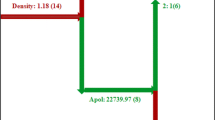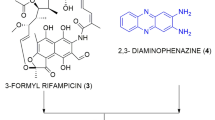Abstract
This paper focuses on the design and antitubercular activity of molecules which are a hybrid of coumarin and pyrimidine nuclei. A set of 16 compounds, viz. 4-(substituted)phenyl-3,4-dihydro-1H-chromino[4,3-d]pyrimidine-2,5-diones and 4-(substituted)phenyl-2-thioxo-3,4-dihydro-1H-chromino[4,3-d]pyrimidin-5-ones have been synthesized using green chemistry principles and evaluated for antitubercular activity by microplate Alamar blue assay (MABA) and luminescence-based low oxygen-recovery assay (LORA) with rifampicin as the standard. The required Mycobacterium tuberculosis H37Rv strain for LORA was cultured using a plasmid bearing an acetamidase promoter driving a bacterial luciferase gene for signal enhancement and were allowed to adapt to low oxygen content in the fermenter. Compounds 5d, 5e, and 5g demonstrated maximum antitubercular activity, with % inhibition values of 58, 55, and 45 based on MABA and 62, 35 and 37 based on the LORA tests at 128 μM. To understand the relationship between structure and activity, recursive partitioning (RP) models were developed. Two different RP models were built, one based on the antitubercular activity and the other based on the toxicity of the molecules. The decision tree could identify descriptors that discriminate the active and inactive as well as toxic and less toxic 3,4-annelated coumarin analogs. This RP model will be utilized in further work to design more potent molecules.
Graphical Abstract





Similar content being viewed by others
References
Amaral L, Kristiansen JE, Viveiros M, Atouguia J (2001) Activity of phenothiazines against antibiotic-resistant Mycobacterium tuberculosis: a review supporting further studies that may elucidate the potential use of thioridazine as anti-tuberculosis therapy. J Antimicrob Chemother 47:505
Barry VC, Belton JG, Conalty ML, Denneny JM, Edward DW, O’Sullivan JF, Twomey D, Winder F (1957) A new series of phenazines (rimino-compounds) with high antituberculosis activity. Nature 179:1013
Bartizal K, Gill CJ, Abruzzo GK, Flattery AM, Kong L, Scott PM, Smith JG, Leighton CE, Bouffard A, Dropinski JF, Balkovec J (1997) In vitro preclinical evaluation studies with the echinocandin antifungal MK-0991 (L-743,872). Antimicrob Agents Chemother 41:2326
Blower P, Fligner M, Verducci J, Bjoraker J (2002) On combining recursive partitioning and simulated annealing to detect groups of biologically active compounds. J Chem Inf Comput Sci 42:393
Choi SY, Shin JH, Ryu CK, Nam KY, No KT, Park Choo HY (2006) The development of 3D-QSAR study and recursive partitioning of heterocyclic quinone derivatives with antifungal activity. Bioorg Med Chem 14:1608
Cohen FL, Tartasky D (1997) Microbial resistance to drug therapy: a review. Am J Infect Control 25:51
Desai B, Sureja D, Naliapara Y, Shah A, Saxena AK (2001) Synthesis and QSAR studies of 4-substituted phenyl-2,6-dimethyl-3, 5-bis-N-(substituted phenyl)carbamoyl-1,4-dihydropyridines as potential antitubercular agents. Bioorg Med Chem 9:1993
Garcia-Garcia A, Galvez J, de Julian-Ortiz JV, Garcia-Domenech R, Munoz C, Guna R, Borras R (2005) Search of chemical scaffolds for novel antituberculosis agents. J Biomol Screen 10:206
Jarvis B, Lamb HM (1998) Rifapentine. Drugs 56:607
Jindani A, Aber VR, Edwards EA, Mitchison DA (1980) The early bactericidal activity of drugs in patients with pulmonary tuberculosis. Am Rev Respir Dis 121:939
Kawakami K, Namba K, Tanaka M, Matsuhashi N, Sato K, Takemura M (2000) Antimycobacterial activities of novel levofloxacin analogues. Antimicrob Agents Chemother 44:2126
Kidwai M, Saxena S, Mohan R (2006) Environmentally benign synthesis of benzopyranopyrimidines. Russ J Org Chem 42:52. doi:10.1134/s107042800601009x
Krajewski WW, Jones TA, Mowbray SL (2005) Structure of Mycobacterium tuberculosis glutamine synthetase in complex with a transition-state mimic provides functional insights. Proc Natl Acad Sci USA 102:10499–10504
Manvar A, Malde A, Verma J, Virsodia V, Mishra A, Upadhyay K, Acharya H, Coutinho E, Shah A (2008) Synthesis, anti-tubercular activity and 3D-QSAR study of coumarin-4-acetic acid benzylidene hydrazides. Eur J Med Chem 43:2395
Manvar AT, Pissurlenkar RR, Virsodia VR, Upadhyay KD, Manvar DR, Mishra AK, Acharya HD, Parecha AR, Dholakia CD, Shah AK, Coutinho EC (2010) Synthesis, in vitro antitubercular activity and 3D-QSAR study of 1,4-dihydropyridines. Mol Divers 14:285. doi:10.1007/s11030-009-9162-8
Marinis E, Legakis NJ (1985) In-vitro activity of ciprofloxacin against clinical isolates of mycobacteria resistant to antimycobacterial drugs. J Antimicrob Chemother 16:527
McKee TC, Covington CD, Fuller RW, Bokesch HR, Young S, Cardellina IJ, Kadushin MR, Soejarto DD, Stevens PF, Cragg GM, Boyd MR (1998) Pyranocoumarins from tropical species of the genus Calophyllum: a chemotaxonomic study of extracts in the National Cancer Institute collection. J Nat Prod 61:1252. doi:10.1021/np980140anp980140a
Miyakawa Y, Ratnakar P, Rao AG, Costello ML, Mathieu-Costello O, Lehrer RI, Catanzaro A (1996) In vitro activity of the antimicrobial peptides human and rabbit defensins and porcine leukocyte protegrin against Mycobacterium tuberculosis. Infect Immun 64:926
Rusinko A III, Young SS, Drewry DH, Gerritz SW (2002) Optimization of focused chemical libraries using recursive partitioning. Comb Chem High Throughput Screen 5:125
Ryabukhin SV, Plaskon AS, Boron SY, Volochnyuk DM, Tolmachev AA (2011) Aminoheterocycles as synthons for combinatorial Biginelli reactions. Mol Divers. doi:10.1007/s11030-010-9253-6
Scott GM, Weinberg A, Rawlinson WD, Chou S (2007) Multidrug resistance conferred by novel DNA polymerase mutations in human cytomegalovirus isolates. Antimicrob Agents Chemother 51:89. doi:10.1128/AAC.00633-06
Shiradkar M, Suresh Kumar GV, Dasari V, Tatikonda S, Akula KC, Shah R (2007) Clubbed triazoles: a novel approach to antitubercular drugs. Eur J Med Chem 42:807
Spino C, Dodier M, Sotheeswaran S (1998) Anti-HIV coumarins from Calophyllum seed oil. Bioorg Med Chem Lett 8:3475
Stover CK, Warrener P, VanDevanter DR, Sherman DR, Arain TM, Langhorne MH, Anderson SW, Towell JA, Yuan Y, McMurray DN, Kreiswirth BN, Barry CE, Baker WR (2000) A small-molecule nitroimidazopyran drug candidate for the treatment of tuberculosis. Nature 405:962. doi:10.1038/35016103
Strobl C, Malley J, Tutz G (2009) An introduction to recursive partitioning: rationale, application, and characteristics of classification and regression trees, bagging, and random forests. Psychol Methods 14:323
Virsdoia V, Shaikh MS, Manvar A, Desai B, Parecha A, Loriya R, Dholariya K, Patel G, Vora V, Upadhyay K (2010) Screening for in vitro antimycobacterial activity and three dimensional quantitative structure–activity relationship (3D QSAR) Study of 4 (arylamino) coumarin derivatives. Chem Bio Drug Design 76:412
Xu Z-Q, Barrow WW, Suling WJ, Westbrook L, Barrow E, Lin Y-M, Flavin MT (2004) Anti-HIV natural product (+)-calanolide A is active against both drug-susceptible and drug-resistant strains of Mycobacterium tuberculosis. Bioorg Med Chem 12:1199
Young SS, Hawkins DM (2004) Using recursive partitioning analysis to evaluate compound selection methods. Methods Mol Biol 275:317
Acknowledgments
The computational, synthetic, and evaluation studies were possible due to the grants received from the All India Council for Technical Education (F. nos. 8022/RID/NPROJ/RPS-5/2003-04 and 8023/BOR/RID/RPS-181/2008-09), Department of Biotechnology (File no. BT/PR11810/BRB/10/690/2009), Council for Scientific Research (File no. 01/2399/10/EMRII) New Delhi and University of Mumbai (F. no. APD/237/157/2010).
Author information
Authors and Affiliations
Corresponding author
Rights and permissions
About this article
Cite this article
Ambre, P.K., Pissurlenkar, R.R.S., Wavhale, R.D. et al. Design, synthesis, and evaluation of 4-(substituted)phenyl-2-thioxo-3,4-dihydro-1H-chromino[4,3-d]pyrimidin-5-one and 4-(substituted)phenyl-3,4-dihydro-1H-chromino[4,3-d]pyrimidine-2,5-dione analogs as antitubercular agents. Med Chem Res 23, 2564–2575 (2014). https://doi.org/10.1007/s00044-013-0850-7
Received:
Accepted:
Published:
Issue Date:
DOI: https://doi.org/10.1007/s00044-013-0850-7




